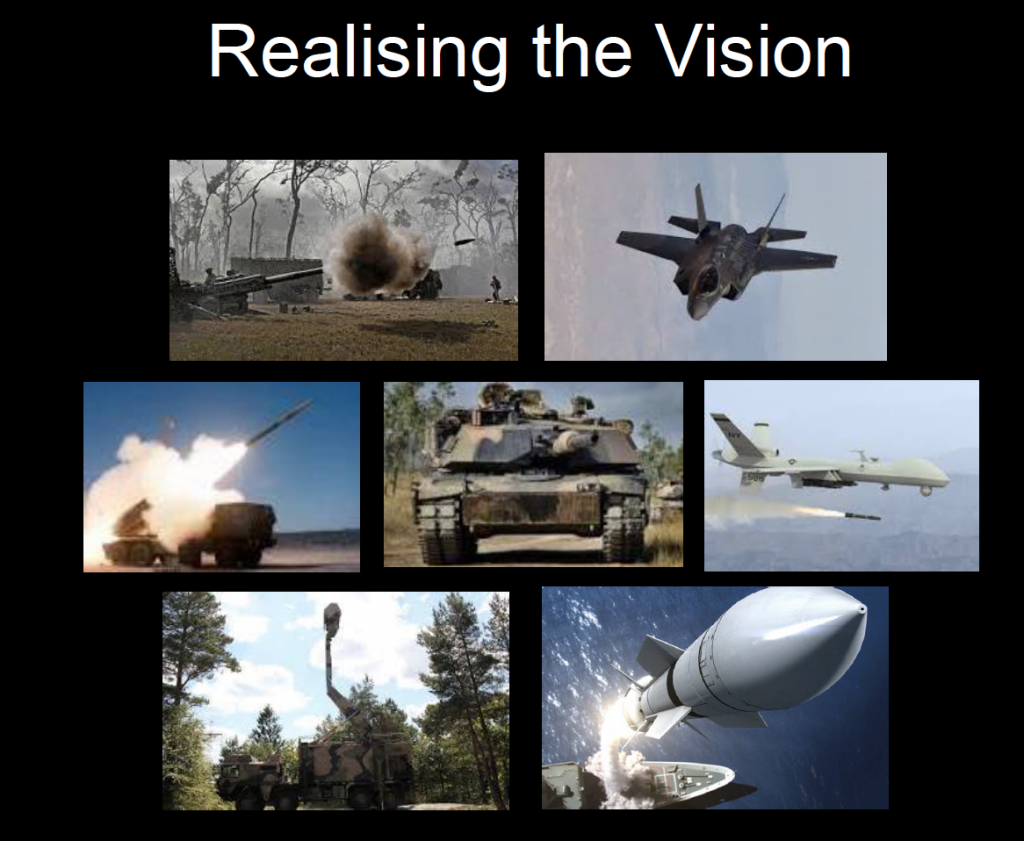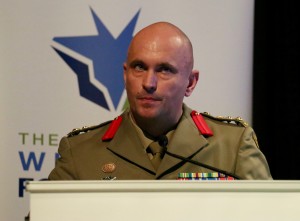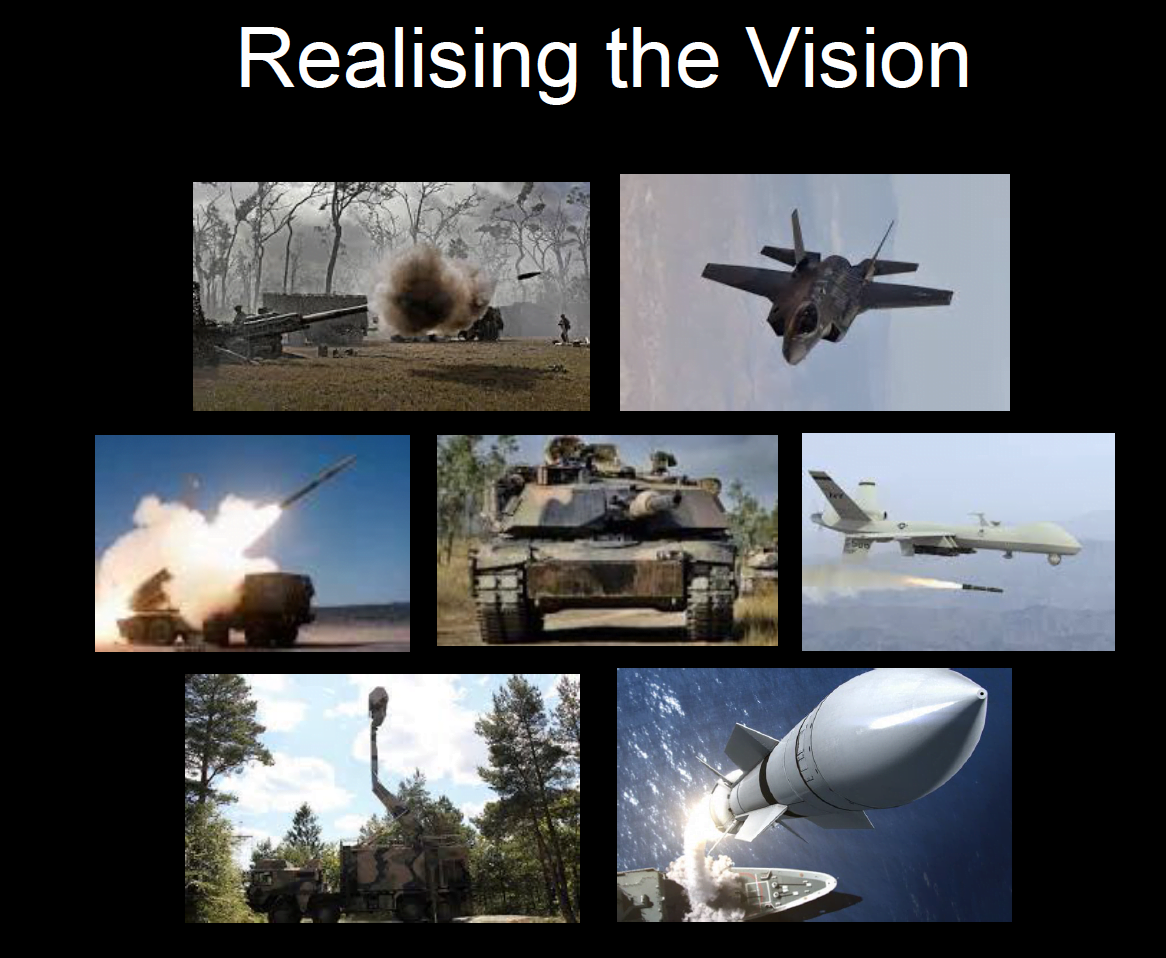2016-04-16 By Robbin Laird
The current Chief of Staff of the Army, Lt. General Angus Campbell and Brigadier General Chris Mills, Director General, Army Modernization provided the Australian Army perspective on the evolving framework for air-land integration under the impact of evolving technologies at the Williams Foundation seminar.
The Chief of Staff clearly underscored that the land wars of the past decade are not the template for moving forward and saw the need and opportunity to shape new ways to integrate airpower with ground maneuver forces in providing for more effective capabilities in the contested battlespace.
The reshaping of Army modernization to achieve the force envisaged by the Army Chief of Staff was provided as well by Brigadier General Mills in his presentation. He provided a hard hitting look at the Army and how the evolving force could shape a more distributed operational and decision-making force, one which he saw as providing for 21st century ground maneuver forces.
I had a chance to follow-up on his presentation to discuss further the approach, which Mills outlined at the seminar, in a meeting at his office on March 21, 2016.
It was clear from Mills presentation that he was thinking beyond the experience of the past decade towards where the technology and new concepts of operations could take the Australian Defense Force.
He emphasized that his background of the past decade was important, but he did not want to be captured by it. We have argued that the approach, which makes sense, is “Harvest the Best and Leave the Rest,” which clearly is his approach.
https://sldinfo.com/how-to-build-a-nike-perspective-for-rebuilding-the-post-afghanistan-us-military/
https://sldinfo.com/“democratizing-the-battlefield”-the-rover-experience/
He highlighted both in the seminar and in the interview the importance of empowering the smaller maneuver group with technology and decision-making capabilities so that the effect, which can be created from joint fires and empowerment, can flow up and down the kill web.
We recently discussed the COIN experience with an experienced US Army officer who highlighted that he was concerned that the US Army was going back to its large stove pipes of separate platforms and specialties.
He argued that the real meaning for US Army officers from the COIN experience was the empowerment of the Forward Operating Base command elements.
“Junior officers were in charge of integrated operations and joint operations in their area of operations.
Now they are being sent back to Pentagon stove pipes.
This makes no sense, and is going the wrong way.
We need to empower the integrative capabilities of the small group, not put obliterate the role of the small group by putting them under the thumb of division headquarters and Pentagon stove pipes.”
This US Army officer went on to note that an Aussie Army officer trained him during his early years in the Army and that the Aussies focus on the battalion level and its importance.
“We need a similar focus in our modernization approach and strategy,” was the view of this US Army officer.
If this officer had been in the room with BG Mills, I am sure he would have found an intellectual soul mate.
During the briefing, Mills included a slide which would not appear in a typical Army briefing, for in this slide, the F-35 and naval fire support were prominently highlighted.

Question: You put up a slide, which highlighted a very comprehensive look at joint fires and support to the ground maneuver forces.
How do you view the way ahead?
BG Mills: We need to move beyond the label of air land integration and look at joint integration or multi-domain integration.
We need to focus on the reality of what it looks like at the small team, combat team level, with regard to multi-domain integration with joint effects from JSF or from the Air Destroyer or from overhead surveillance systems.
I think the reality is that as we move beyond this decade, those type of joint effects need to empower the small team to achieve tactical success as the array of tactical successes transcend into an operational impact.
So a number of what would be seen as operational effects I think in the fullness of time will transcend all the way down to the small team, combat team level.
Hence, when a combat team commander who is about to attack a city block can potentially compartmentalize all the electronic emissions going out from that block to know exactly where the threat is.
Then he can look at a whole range of joint fires both lethal and non-lethal to support them in achieving their objectives.

Brigadier General Mills, Australian Army, addressing the question of Army modernization under the influence of evolving air capabilities.
Question: What you talking about is shaping the right kind of joint force package designed to achieve a particular mission set in a timely manner?
Answer: The overall challenge is to generate more force, more rapidly, and more effectively when called to do so. That is the joint mission; it is not just about the Army.
Question: In some ways, what you are describing is taking the mental furniture of the Special Forces and applying more broadly to the Army?
Answer: That is a fair way to put it. The Special Forces are generally able to channel a whole range of joint effects for their particular tactical tasks.
They might have strategic effects but the reality is we need to take as you said that mental framework and apply that to what we call the joint land force.
All of those services that are collectively working to fight with Army to fight the land battle is referred to within the ADF context as the joint land force. That joint land force is by nature purple.
Although it was predominated by army people the reality is it needs to work as a joint organization and I would like to go back to the point you discussed.
Not only do you have to package this small team, but this small team has to be capable of dynamically repackaging the force on the fly with joint effects. For example, if you now need additional EW, the combat team will able to leverage additional EW from the joint force.
You now need the ability to coordinate direct air land integration fires and you need more F-35 support to deliver that effect.
The reality is that we potentially need to look at as we move beyond this decade of pushing support further down from division level and making it more readily available and more dynamically available to the small group level.
The time responsiveness of an Air Tasking Order that’s 72 hours old is really not going to make it.
I would suggest that time line needs to be radically truncated.
The Chief of Army made the point at the Airpower Conference that in many ways we are still using procedures and approaches that go back to World War II for air-ground operations; this makes no sense in terms of technological advances and operational shifts.
We need to shape a 21st century approach.
It is as a said, not about air-land integration, it is multi-domain integration at the small group operating level.
Question: A key question involves C2 and information parsimony. It is really about empowering the maneuver group with in the words of Air Commander Australia, “right information at the right time.”
Answer: The importance will be on the filter that can potentially gather up all of this data.
What’s the most important time sensitive information I need?
The ability to pull data that’s relevant to the combat situation at the time, and to use rapidly is what we need, not vast collections of data to be examined by historians.
That’s going to be a key for us because we’ve got so many senses now that are currently connected to our C2 systems within the ADF we’re potentially overwhelming ourselves.
We are reaching the maximum capacity of our processing exploitation and dissemination capability.
We need to provide that filter and connect information up to provide intelligence.
Latency is important here. It might be the best bit of intelligence but if it arrives too late it’s worthless.
Question: During your presentation at the Williams Foundation seminar, you showed a small UAV which costs around $12,000 which can be used by the small combat group.
You made the point that it was not just about enabling the small group, but opening up the possibility that the close contact picture might be then available to support the overhead or sea-based strike force.
Could you discuss your thinking here?
Answer: When that information stops becoming just important to that squad leader, platoon commander or company, it can become crucial for divisional commanders as well.
Suddenly the squad leader has identified a hot priority target. I’ve got imagery of a high priority target, hot value target that’s time sensitive from the squad commander.
How long does it take currently to pass that information up to the strike element?
This will only happen if the squad leader can jump the net and move directly to the fire cell within division so that that he can talk directly to the divisional asset and potentially the plane overhead, to coordinate the fires.
I think it’s this issue to work out the decision loop.
You want to connect the key people that need to be involved in a particular joint fire and potentially jump those who need the information but do not need to make a decision.
BG Mills closed by noting that he had nothing but respect for the U.S. military and its performance during his time of service in the Middle East.
“I have had the great privilege to work with some amazing US generals and some amazing US men and women in uniform.
I am in awe over what the US military has achieved in the past two decades supported by the American people.
I have learned a lot working with the United States military.”
Given the perspective of BG Mills, the slide, which we developed to capture the discussions with the RAAF and in the seminar generally, can be applied to the ground maneuver force as well as to considering the evolution of the RAAF itself.

The biography of Brigadier General Chris Mills:
Brigadier Chris Mills was born in Brisbane, Queensland, on 10 June 1969. Following graduation from university Brigadier Mills resigned his commission in the Reserves to enlist in the Regular Army and train at the Royal Military College Duntroon. He graduated from Duntroon to the Royal Australian Armoured Corps in June 1991. Brigadier Mills attended the Australian Command and Staff College in 2004 and attained a Masters of Management. Brigadier Mills has served in a range of regimental, training and staff appointments within Army and has served on a number of Joint and Inter-Agency headquarters.
Post staff college, Brigadier Mills was employed as the Military Assistant to the Deputy Chief of Army and worked within the Directorate of Capability and Development, Future Land Warfare, in Army Headquarters. In 2009-10 Brigadier Mills was privileged to be the commander of 2nd/14th Light Horse Regiment (Queensland Mounted Infantry).
Brigadier Mills was promoted to Colonel on 17 January 2011 and assigned the position of Director Military Commitments Army; responsible for overseeing Army’s commitments to operations, domestic tasks and exercises, and managing Army’s preparedness reporting.
In 2013, Brigadier Mills was appointed the J73 in Headquarters Joint Operations Command, responsible for the design, planning and conduct of Joint and Combined Exercises. In 2015, he graduated from the Centre for Defence and Strategic Studies and completed a Masters of Business Administration.
He was promoted to his current rank with effect 18 January 2016 and assumed the positions of Director General Modernisation and Director General Land 400.
Brigadier Mills has had operational experience in Bosnia and Afghanistan.
In 1999 he was employed within a British Armoured Infantry Battle Group in Bosnia.
In 2007 he deployed as Deputy Chief Plans within Headquarters International Security Assistance Force Afghanistan (ISAF).
Over the period August 2012 to August 2013 he deployed to Afghanistan as the Headquarters Regional Command South Chief of Future Operations, responsible for Divisional level planning and operationalizing base closure.
His academic achievements include a Bachelor of Science, Masters of Management and a Masters of Business Administration. His leisure interests include military history, rugby, distance running and a variety of other outdoor activities.
Also, see the following:


